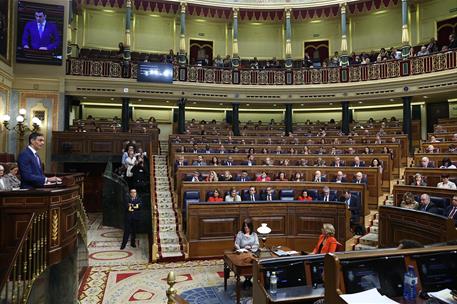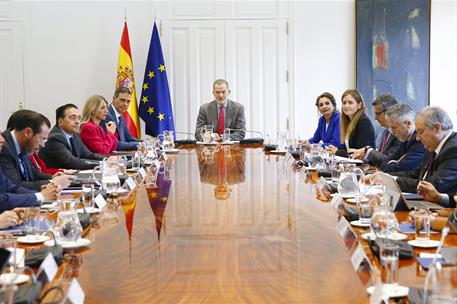Council of Ministers
The Government of Spain presents the report on the causes of the blackout, which was due to a "multifactorial" surge
Council of Ministers - 2025.6.25
Moncloa Palace, Madrid
The Minister for Ecological Transition and Demographic Challenge, Sara Aagesen, with the Minister for Education, Vocational Training, and Sports, Pilar Alegría, during the press conference after the Council of Ministers (Pool Moncloa /Borja Puig de la Bellacasa)
The Third Vice-President of the Government of Spain and Minister for Ecological Transition and Demographic Challenge, Sara Aagesen, presented the report of the committee that analysed the circumstances of the electricity crisis of 28 April to the Council of Ministers. The document, approved by the National Security Council, will be made available to the public today.
Conclusions on the 28 April power blackout
At the press conference after the Council, Aagesen stressed that the committee, made up of renowned professionals and teams from different ministries and organisations, has worked "tirelessly" to identify the causes of the blackout and propose improvements. Their work, she added, has made it possible to have this report available in 49 days, practically half the time Spain has to submit it to the European Commission.
The vice-president pointed out three premises that guided the committee: rigour, the cooperation of the actors and the search for concrete proposals. She also pointed to the existence of "contradictory" or "incomplete" data, as well as the fact that some information "finally did not arrive", which is made explicit in the report. The document respects two maxims: the commitment to transparency and the obligation of confidentiality. The identifying details of companies and legal persons are omitted in order to safeguard this confidentiality and also "to protect the integrity of the proceedings arising from the events that took place," as the minister explained.
The work has been divided into a group dedicated to cybersecurity and digital systems and another to electricity system operations.
No evidence of cyber-attacks
The Third Vice-President of the Government of Spain and Minister for Ecological Transition and Demographic Challenge, Sara Aagesen, during the press conference after the Council of Ministers | Pool Moncloa /Borja Puig de la Bellacasa
Sara Aagesen assured that "the largest cybersecurity investigation that has ever taken place in our country" concludes that "there is no evidence of cyber-incident or cyber-attack as the cause of the energy crisis, neither at the operator nor at the different levels." The committee did identify "vulnerabilities, gaps or misconfigurations of security measures that may expose networks or systems to potential future risks," she said.
The research involved more than 75 people in six teams, with unprecedented public-private coordination and three levels of analysis: the system operator, the control centres spread throughout the territory and the generation facilities.
Chronology of the blackout
The committee analysed millions of pieces of data on electricity system operations, from technical reports and operator assessments to measurements of variables such as voltage, frequency and power. The report structures the events in five phases: the instability on the morning of the blackout and even the previous days; the oscillations between 12:00 and 12:30 on 28 April; the generation losses; the peninsular collapse and the supply restoration phase.
The vice-president detailed that on 27 April the system operator, Red Eléctrica, programmed 10 thermal power stations throughout the country for dynamic voltage control the following day. However, at 20:00 on 27 April, one of the planned plants declared that it would not be operational on 28 April; the operator decided to reschedule but not to replace that thermal fleet in the central hours of 28 April. Aagesen also pointed out that there was already instability in the system as early as 09:00 on the morning of the 28th and that it worsened from 10:30 onwards, although the voltages were within the limits allowed by regulation.
In the second phase, oscillations in the system were recorded. "I am not talking about ups and downs, but about swings", said the vice-president, who stated that the oscillations are "relatively frequent" and that the operator is an expert in managing them because Spain is at one end of the European system. However, at 12:03 there was an "atypical" and more frequent than usual oscillation. With the information available, it can be traced back to the peninsula and linked to "a specific installation and anomalous behaviour".
The Minister for Ecological Transition and Demographic Challenge, Sara Aagesen, together with the Minister for Education, Vocational Training, and Sports, Pilar Alegría, explain the agreements adopted by the Executive | Pool Moncloa /Borja Puig de la Bellacasa
In response to this oscillation and another one that occurred at 12:19, related to the centre of Europe, the operator applied the existing protocols. The measures were effective, but they also caused voltages to rise. To control it, the operator ordered a new power station to be connected in the south, but it took an hour and a half to activate. The vice-president said that, in addition, the operator detected that "the plants that were available to control voltage and those that had also been programmed to do so due to technical restrictions were not regulating voltage in accordance with the regulations."
In the third phase, from 12:32, there was a "rapid, sustained and linear" rise in voltages, accompanied by disconnections of infrastructures in Granada, Badajoz and Seville, among other places. Sara Aagesen pointed out that some of these disconnections were within the authorised limits to protect the installations, while others "occurred inappropriately".
The high voltages led to a chain reaction in which the disconnection of each plant led to the disconnection of the next and, in addition, the ability to interact with Europe via France was lost. Due to the inability to regulate voltage, the system collapsed at 12:33:30.
Multifactorial origin
The vice-president argued that the blackout "had a multifactorial origin, that is to say, a combination of factors converged."
Firstly, the system did not have sufficient dynamic voltage control capability. "Capacities were missing either because they were not sufficiently programmed, or because those that were programmed did not adequately provide what the standard said, or a combination of both," said Sara Aagesen.
The Third Vice-President of the Government of Spain and Minister for Ecological Transition and Demographic Challenge, Sara Aagesen, at the press conference | Pool Moncloa /Borja Puig de la Bellacasa
The second cause was that the swings conditioned the system: the operator implemented the planned measures, but these in turn led to a situation of increased voltages.
Thirdly, there were disconnections, some of which "were apparently improper". This contributed to the escalation of voltage, Aagesen said, arguing that the "point of no return" could have been avoided if "early action" had been taken to control the voltage.
Measures to maintain leadership in the energy transition
The Minister for Ecological Transition announced that, based on the measures identified by the committee to ensure that the blackout "does not happen again", the next Council of Ministers will approve a series of actions to reinforce the system and cybersecurity.
Among the initiatives she announced are the reinforcement of oversight and verification of compliance with obligations by all system agents; the reinforcement of resources that can control voltage, including all renewable generation facilities; the acceleration of transmission grid planning; the commitment to storage; the improvement of interconnections; and the tackling of cybersecurity vulnerabilities.
The report, Aagesen concluded, "allows us all to reflect, but also to act" and will help Spain to maintain its leadership in the energy transition, which is a vector for growth, employment, competitiveness and foreign investment, as well as to advance towards strategic autonomy.
More financial resources for communities and municipalities
The Council of Ministers has approved a Royal Decree-Law to update the payments on account for the Autonomous Communities and Local Entities for 2025, which reflects the Government's commitment to providing local and regional authorities with sufficient resources to provide quality public services. The Lower House of Parliament will have to validate this rule. The update takes place in a scenario of budgetary prorogation and its approval depends on these administrations increasing their economic resources.
The Minister for Education, Vocational Training and Sports and Government Spokesperson, Pilar Alegría, stressed that these territories "will receive the largest economic resources in history". Specifically, the autonomous communities and the autonomous cities of Ceuta and Melilla will receive 147.412 billion euros this year, 9.5% more than the previous year, and the local councils will receive 28.734 billion, also a record figure.
The proposal was transferred to the autonomous communities at the Fiscal and Financial Policy Council held in July 2024 by the First Vice-President of the Government of Spain and Minister for Treasury, María Jesús Montero, and included in December in another royal decree-law, which was repealed because it was not supported by the main opposition party.
Pilar Alegría stressed that the Executive has once again promoted this measure "so beneficial for all the communities and town councils in our country" and urged the parliamentary groups to vote in favour of it. As an example, the spokesperson pointed out that Andalusia will receive 27.435 billion euros, 9.6% more than the previous year, and Aragon will receive 4.974 billion, 9% more.
The minister also recalled that, in the seven years of a progressive government led by Pedro Sánchez, the autonomous communities have received 300 billion euros more in funding than in the previous seven years, which represents a 47% increase. For their part, local entities have received almost 40 billion more, i.e. 32%.
Compensation for asbestos victims
The Minister for Education, Vocational Training and Sports and Government Spokesperson, Pilar Alegría, during her speech at the press conference after the Council of Ministers | Pool Moncloa /Borja Puig de la Bellacasa
The Council of Ministers has approved the procedure for financial compensation for victims of asbestos exposure, recognised in the fund created by law in 2022.
Beneficiaries will receive compensation in the form of a lump-sum payment from this fund. Compensation will range from 32,000 to 96,000 euros, depending on the pathology suffered as a result from the exposure.
Pilar Alegría said that the measure adopted today "responds to a historic demand" of those affected: "We know that much of the harm caused to these affected people is difficult to repair, but listening to them and reaching this mechanism was a matter of justice."
Emissions offsets to the electro-intensive industry
The Executive has authorised the 600 million euros to compensate indirect costs to sectors and sub-sectors deemed to be exposed to a risk of 'carbon leakage' over the period 2021-2030.
This aid, as Pilar Alegría recalled, is included in the PERTE for Decarbonisation, shows the Government's commitment to the electro-intensive industrial sectors and makes it possible to improve their competitiveness, strengthen their industrial capacities and employment.
TEAM ESPAÑA programme allocations
The Government has authorised the Higher Council for Sports (HCS) to call for the aid to Spanish sports federations for the Team España Élite and Team España Estratégico programmes, which will amount to 19 million euros in 2025.
These programmes were launched in 2022 to boost the performance of Spanish athletes and retain technical talent. The spokesperson for the Executive stressed that the most immediate objective is for Spanish athletes to increase the number of medals won at the Olympic and Paralympic Games in Los Angeles compared to previous editions.
Non official translation






